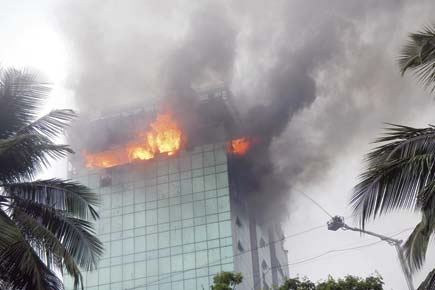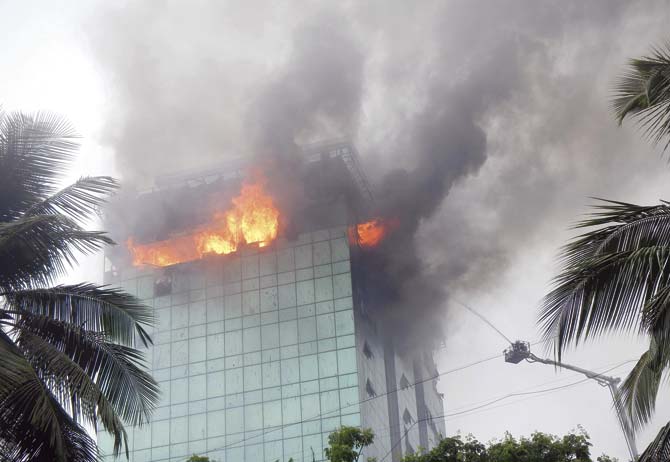With the BMC’s draft development plan clearing the deck for the city to have even taller buildings, fire officials admit the department is ill equipped to fight blazes in highrises

The city is set to grow vertically, but the fire department seems ill equipped to deal with the life-threatening challenges that this may pose.
ADVERTISEMENT

A senior fire official said the signal issue had been faced by firefighters engaged in dousing last year’s Lotus Business Park fire in Andheri as well. File pic
As reported by mid-day (Mumbai may grow by size of 6,380 Oval Maidans!’, February 17), the BMC’s draft Development Plan (DP) has cleared the decks for the city’s vertical growth in the form of even taller skyscrapers by allowing a maximum Floor Space Index (FSI) of 8.
Speaking on condition of anonymity, fire officials, however, admit that, owing to a lack of proper equipment, the Mumbai Fire Brigade is not prepared for firefighting in highrises. This was borne out by the fire in the 23-storey Lotus Business Park building in Andheri last July, which had seen one fireman losing his life and at least 10 others sustaining injuries.
The BMC currently has only three fire-fighting vans that can tackle fires in high-rises and the van with the tallest ladder has a reach of barely 67 metres, while the city already has high-rises that are nearly four times as tall. The Imperial Towers in Tardeo (which were constructed in 2010), for instance, are 254 metres tall and have 61 storeys.
The BMC has purchased a fire-fighting snorkel van from Finland, which is expected to arrive in May, but even that has a reach of barely 90 metres (or 30 storeys). Fire officials say they are also facing issues like loss of wireless signal and difficulty in carrying fire-fighting equipment to the upper floors of the current highrises and that these problems will get exacerbated as the skyscrapers get taller.
Signal issues
A senior fire department official, who has been part of several firefighting operations, told mid-day that one of the most important things in such situations is communication between those leading the operation and the firemen dousing the fire and rescuing people.
“Highrises are like death traps for firefighters. Lack of proper ventilation leads to dense smoke being accumulated and wooden furniture burns to produce nitrogen and carbon monoxide, making the air toxic. While fighting fires in high-rise buildings, we can’t even see each other and have to depend on walkie-talkies to figure out where we are supposed to go and where the trapped people are,” said the official.
“In such situations, wireless communication could mean the difference between life and death not only for the firefighters but also for the people trapped inside the buildings. In highrises, however, wireless signals take a huge hit above the 20th floor. The buildings are made of thick concrete and steel and the signals get weaker the higher up we go.
This hampers the rescue operation because we are not able to understand the instructions given by officials. We have to act purely on instinct and we fear for our life in such situations,” he added. “The signal issue had taken place even during the Lotus Business Park fire. We want development, but not at the cost of fire-fighters’ lives,” said the official.
Officials say that the signal problem has been known to the fire department for some time now and a proposal was also floated to make installation of Bi-Directional Amplifiers (BDAs) or signal boosters a must in all new high-rise buildings. They said, however, that the plan has not seen light of day because higher-ups in the department have been dragging their feet on the issue.
No scope for ‘van’ity
While skyscrapers have already breached the 250-metre mark, the Mumbai Fire Brigade has only three fire-fighting snorkel vans meant for highrises with a maximum reach of just 67 metres. The fire brigade also has to contend with other limitations while using these vans. The new van is expected to have a length of 18 metres (60 feet), which means it will require a large space for turning, which is very hard to come by in the city.
“Areas like Nariman Point, BKC and Backbay are on reclaimed land and there are chances of cave-ins due to the high pressure of the vehicle’s jack if the snorkel is used there. It is also very difficult to use these vans in areas where the gap between two buildings is less,” said a senior fire department official.
Stair-struck
Firemen who carry out the dousing and rescue operations say that they face another major problem while dealing with fires in high-rises: Physically carrying the fire-fighting equipment up the stairs to as high as 20 floors or even higher, to the floor where the fire has broken out.
“Since the mandatory fire-fighting equipment in most buildings does not work, we have to carry things like booster pumps and pipes to the upper floors using the stairs, as lifts can obviously not be used in such circumstances. This is very tough job and we are already half-drained by the time we get to the floor where the fire has broken out,” said a fireman.
 Subscribe today by clicking the link and stay updated with the latest news!" Click here!
Subscribe today by clicking the link and stay updated with the latest news!" Click here!






